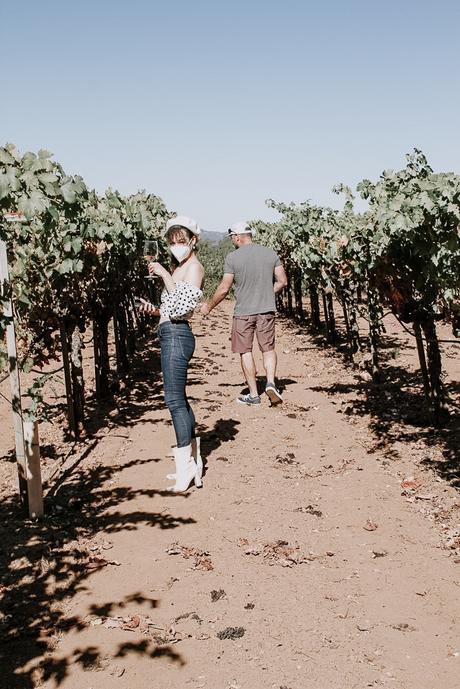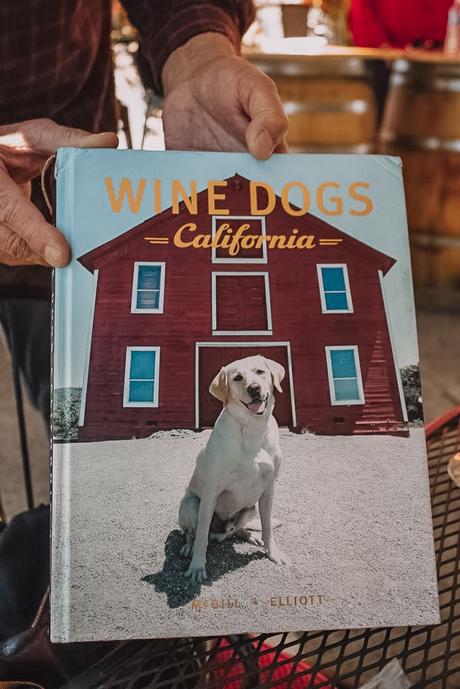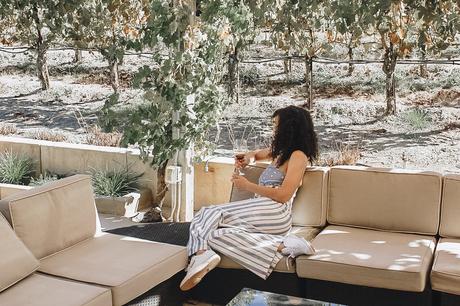
Driving North up on the 101, I found myself getting emotional - Shaun and I were off to do something that I personally hadn’t participated in since the first weekend of March: wine tasting. Sonoma County has confronted many challenges since that time: including two major fires, and the evacuation of Dry Creek Valley.
For me, returning to wine tasting was surreal in another way: just a few weeks earlier I had published a now viral piece of content with KQED: I Have Supported the Wine Industry for Years. Why Won’t it Support Me? And, I wasn’t sure how to do this: step back into wine and hospitality after the article. Had I waited “long enough” to return wine content? And if so...how would I step back into it? Things were different now, in so many ways.The biggest difference is that I have taken a very public and prominent stand for social and racial justice within Sonoma County. I have, along with fellow comrades, organized local protests and used my social media platforms to stand up for Black, Brown, and Indigenous Persons of Color (BIPOC) and LGBTQ+ rights. I have spoken on panels, co-lead marches, die-ins, written articles, co-hosted radio shows, spoken on podcasts and Facebook Live series, and confronted our local Police Chief about our social issues. And, I turned my focus on the wine industry to hold it accountable: because it is black and brown hands that pick the grapes. Sonoma County is a farming country first, and a wine country second.
So...while driving to our first winery of the day, I found myself asking myself ‘is it safe to visit? What does wine tasting look like now?’ And, ‘how do I do this? How do I move about this space as authentically as I can?’ The first answer was: yes. It is safe to visit wineries and wine taste during these times. Wine tasting looks different now: reservations are now required to avoid crowds, tables are evenly distanced apart, hosts wear masks, and disinfect tables between appointments.
The answer to my second series of questions didn’t come right away. Rather the answer came later, from a BIPOC Assistant Winemaker, Justin Trabue, whom I spoke to for a different article: “Ashtin Berry explains how the erasure of presenting wine as an agricultural product, but rather as a luxury product results in inequality. Exhibiting wine as a luxury good allows for the gatekeeping of wine to continue, rather than providing opportunities”.
There are several changes in behavior and approach that this industry will need to make if it is to survive and adapt to new and younger generations. One of those changes is to become more approachable. Of the three wineries I visited, I feel that the industry is starting to understand this. There is a humility of knowing that it isn’t just enough to create great wines: the brand has to be approachable, and human too.
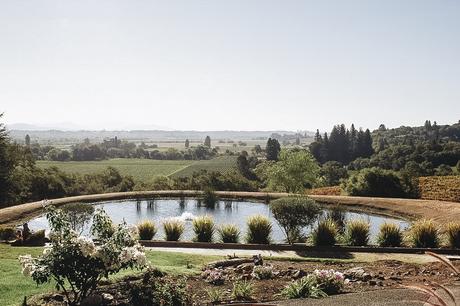 Armida Winery
Armida WineryOur first interaction at Armida Winery was a smile and a wave: Shaun and I had pulled over to take the introduction shot: a Boomerang Instagram Story to announce to my audience that today I would be working with Zinfandel Advocates and Producers (ZAP) and touring the Dry Creek Valley to taste some amazing Zinfandel wines. We had arrived shortly before opening. A large white truck pulled up, and I scrambled to jump into the car so as to not be in the way. “Oh no no you’re good! I get it! It’s a beautiful shot! Look forward to seeing you real soon.” Brandon, our host and Armida Winemaker later told us that was the owner, Bruce. “He has a way of making every guest feel like they’re old friends.” Brandon has that quality too.
During our tasting we learned that there are vineyard blocks named after adopted rescue dogs. We learned that what got Brandon into winemaking was his grandfather. Brandon says that Armida Winery produces a lot of covetable fruit due to their unique vineyard locations, and care of the grapes - but that he also recognizes that wine must be approachable. Armida nails that balance: exceptional winemaking, hosting a welcoming atmosphere, and producing very drinkable wines.
My favorite standout wine from this tasting? Visit my feature on the ZAP Zinfandel Blog: A Safe and Healthy Tour of Dry Creek to read more.
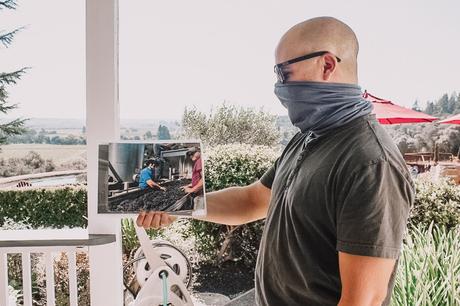
Martinelli Winery
Tessa, our host greets us at the entryway with a glass of rosé. She is bubbly and inviting, and even though we’ve just met, I am so happy to see her. Her personality is one that brings you into the fold right away, and already, I simply just want to be her friend. (I will later tell her through Instagram DM that I “could hug her” when she tells me great news. and she kindly reminds me that we are in a pandemic.😅)
While touring the grounds she introduces us to their Winemaker, Courtney Wagoner. Courtney informs me that she and her team will go through their Zinfandel grape clusters with tweezers in efforts to make sure only the best of the best make it into production. I am intrigued.
Martinelli Winery was the only winery of our three experiences that served snacks. I understand that there are wine tasting purists who only want wine during a tasting, but...I love cheese and I love crackers, and I have a strong opinion loosely held that the two should be served together at all times. Thank you Martinelli for giving us snacks. I could hug you (but I won’t - pandemic, I know).
Our wine tasting experience is held on their large stone terrace, one that backs right up to a vineyard block. It’s shaded by oak trees, has a bubbling stream, and is shaded by a pergola with climbing Zinfandel vines. Tessa tells us the story about the Jackass Hill Vineyards and already I find myself wondering how many times it took her telling this story in order to keep a straight face. I know I’d giggle every time - like now.
Giggles aside, the Martinelli Jackass Hill Vineyard is an unique one - and the only one of its kind. Planted in the 1880’s, it is the steepest vineyard sans retaining wall in all of Sonoma County. (Due to current regulations, there won’t be another one like it, either.) the uniqueness of the wine really shines through too - for my stand out favorite, head here.
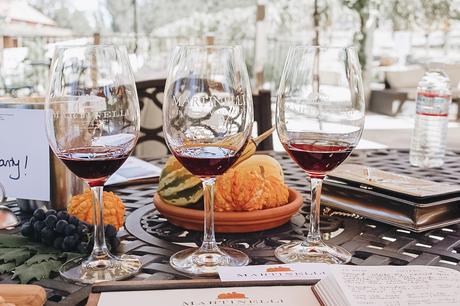

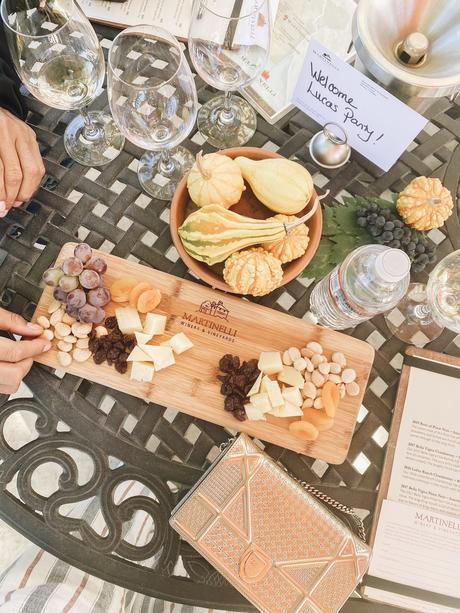
Kokomo Winery My friend Victoria accompanies me to this winery - because when it comes to winery visits I must allocate the wine time evenly, as she reminds me. I have never been to Kokomo Winery- and I very nearly missed it too: the driveway is on a road curve, and up a hill. It could be easy to miss: so do keep your eyes open!
We are greeted by my friend and host, Kevin, and Westdale, the resident doggo of Kokomo. Suddenly I am of the opinion that all wineries should have resident pets. We are asked to use the hand sanitizer at the host stand, and all tables are evenly spaced more than 6ft apart. There is plenty of plant foliage, and I admire a fiddle leaf tree: it’s huge, and I really wish I could have one in my home.
While Kevin starts us off with a pour of 2019 Grenache rosé, and leaves us to settle in, Erik the owner sneaks in and steals us away for a secret tour. “I’m not supposed to do this” he says “but I just wanted you to see these views”. And yes: the views are worth it. As we walk through the vineyards we discuss co-fermentation and how it differs from wine blending. Co-fermentation is just how it sounds: when grapes of various varietals are fermented together, rather than blended after the fermentation process. I personally believe that it is the future of wine making - especially for younger generations.
Safely returned back to our tasting table, Kevin introduces us to Kokomo’s three Zinfandel wines: to which there is certainly one that will get your attention. The winemaking here is playful and unique, while also remaining true to what one would “expect” from a Zin. There is a Zinfandel for everyone - and yes, my favorite can be found in my ZAP feature.
Thank you to ZAP for hosting me, and for the writing opportunity!
